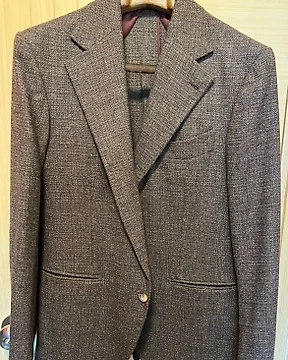Clothing
925 objects
Questions? Our Clothing experts have answers
Luxury clothing brands are the opposite of fast fashion brands and there are many traits that distinguish luxury clothing brands from regular ones.
First, luxury clothing brands manufacture high-quality clothes using top-notch materials. Some high-quality materials luxury clothing brands use include organic cotton, silk, and Tencel.
Next, luxury clothing brands don't mass-produce garments. They tend to produce garments in small batches, allowing for multiple quality assurance checks during production.
Additionally, many luxury clothing brands offer exclusive products to create scarcity. This drives up the value of their products as consumers are willing to pay a premium for apparel that isn't widely available.
For instance, Gucci, one of the world's most valuable luxury clothing brands, releases limited edition products every so often. For example, in 2017, the Italian apparel brand released a leather jacket that cost a staggering $18,650.
Many luxury clothing brands partner with prominent personalities to advertise their products and demonstrate their association with glitz and glamor. For instance, Louis Vuitton uses four-time Oscar-nominated actress Saoirse Ronan to promote its products alongside celebrities like Zendaya and BTS's J-Hope.
Besides these characteristics, some other key traits of luxury clothing brands include a strong brand identity and exceptional and bespoke customer service.
Other than Louis Vuitton and Gucci, other popular luxury clothing brands include Chanel, Dior, and Armani.
Charles Frederick Worth is often credited as the first fashion designer in the modern sense of the term. Known as ''The father of haute couture,'' or "the first couturier," Worth got his start in the textile and drapery business. After moving to Paris in 1845, his career took a decidedly different turn.
Worth began his career in Paris selling textile items for Gagelin-Opigez & Cie, a fabric firm based in the city, and later established a dressmaking department there. After spending time with the company refining his dressmaking talents, Worth took the risky step of launching his own fashion house, House of Worth, in 1858.
Instead of accommodating his customers' requests, Worth was ahead of his time when it came to dictating what they should wear.
Additionally, he was an innovator in the field of fashion shows, where live models would exhibit his designs to an exclusive group of nobility and aristocracy. Back then, mannequins were the only way to display clothing, therefore using live models was a fresh and unique concept.
He became the first designer to launch a couture business with a strong brand identification when the business of Worth's designs, made renowned by his innovative ideas and distinctive garments—became famously associated with Worth himself.
Worth revolutionized the fashion industry by bringing dressmakers and sewists out of the shadows and into the spotlight, where they could proudly display their works. This paved the road for modern fashion.
Vintage clothing is a generic term for genuine clothing from an earlier era. The term was first coined in the 1920s to refer to garments that were popular in the past. However, the term became mainstream about two decades later as more people began to collect and value vintage pieces.
While vintage is often used to refer to all types of old clothing, an authentic vintage item must be at least 20 to 100 years old. This means that garments from the 1920s to the early 2000s may be considered vintage. However, if a garment is over 100 years old, it is considered antique rather than vintage.
Similarly, while the terms vintage and retro are often used interchangeably, they aren't the same. Retro, short for retrospective garments, are usually clothes made recently that mimic the style of a bygone era. For instance, a grunge-looking t-shirt made in the 2010s won't be considered vintage but retro.
Besides age, vintage clothes must also clearly reflect the styles and trends of the era they originate from to be considered vintage. For instance, vintage clothes from the early to mid-1990s may showcase the grunge style that was popular at the time and include items like ripped or faded jeans, shabby-looking t-shirts with rock band logos, and clunky combat boots.
Petite clothing is clothing designed specifically for women who are 5''4 (163 cm) and under. However, some clothing brands offer petite clothing for women who are 5''5 (165 cm). This is why it's essential to check the brand-specific sizing chart of a brand when shopping for petite clothing.
Developed in the 1940s by fashion designer Hannah Troy, petite-size clothing isn't based on weight as many people think. Instead, it's primarily concerned with height.
Unlike regular-size clothing that may be too long in the sleeves, legs, or torso, petite clothing caters to women with smaller frames. Petite-size clothing has shorter sleeves, hemlines, and bottoms to flatter the frames of petite women.
Besides height, petite-size clothing also takes into consideration body proportions. Petite-size clothes typically have narrower shoulders, higher armholes, and higher waistlines than regular clothing. Thanks to these traits, petite-size clothes offer women with smaller frames a more flattering and snug fit.
While it's a common misconception that petite clothing is designed for slim women, it is suitable for women of any body shape, from slender to plus-size. Generally, petite clothes are ideal for women who are 5''4 and under, have short legs, have narrow shoulders, and have short torsos.






















